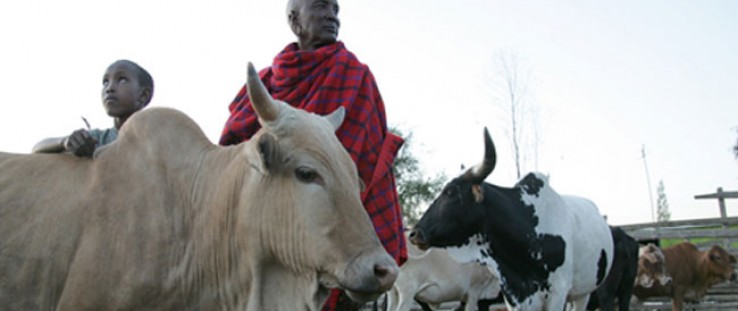 A Maasai father and son tend to their cattle in Kitengela, Kenya.
A Maasai father and son tend to their cattle in Kitengela, Kenya.
 A Maasai father and son tend to their cattle in Kitengela, Kenya.
A Maasai father and son tend to their cattle in Kitengela, Kenya.
The drylands of East Africa are home to millions of pastoralists, herders who move from place to place in search of water and pasture for their livestock. Drought years are tough for these families, who depend on their animals—cows, goats, sheep and camels—for both food and income. In a drought, pasture and water become much harder to find, and the livestock can weaken and die.
Now, climate change is making matters worse. Seasonal rains are becoming less predictable, and droughts more frequent and more severe.
“It is very rare to see regular rainy seasons like before,” said Qabale Hapi Jillo, a pastoralist from the village of Duba Goba in Kenya. “Since I lost almost all my livestock to drought, I became a charcoal burner, which is very difficult work for an older woman like me.” Charcoal burners gather and slow-burn wood to produce charcoal, which is then sold as fuel.
Traditionally, pastoralists have coped with the threat of drought by keeping mobile, and by sharing grazing areas that they use for a time, and then let lay fallow and regrow. They also build wells and ponds to store water. More recently, they have started replacing cows with camels and goats, which are more likely to survive when water becomes scarce. Sometimes, after a serious drought, pastoralists give livestock to other community members who have fewer surviving animals.
But with climate change, pastoralists have less time to recover and rebuild their herds between dry spells. This leaves them vulnerable, and subsequent droughts can threaten their very survival. Moreover, when everyone in the community is suffering at the same time, it becomes harder for them to help each other through the crisis.
In 2008, USAID began supporting new programs to insure East African pastoralists against the loss of livestock in case of serious drought, thereby building the resilience of these vulnerable communities. A new product—index-based livestock insurance (IBLI)—is being developed and tested in the Marsabit district of northern Kenya and the adjacent Borana region of southern Ethiopia. In these areas, pastoralists are raising over 18 million cows, goats and sheep.
Agricultural insurance is common in developed economies. In the United States, for example, the government provides American farmers with approximately $80 billion in coverage through the Federal Crop Insurance program. Livestock insurance is also available to cover rising feed prices and falling market prices for milk and meat, among other costs. Insurance against livestock death is available through private insurance companies.
In most of East Africa, however, insurance and similar types of risk management tools are not available to vulnerable pastoralists or smallholder farmers. “Insurance in the agricultural sector is seen as riskier than other sectors,” notes Tesfaye Desta, chief executive officer of Oromia Insurance Company in Ethiopia.
“Without insurance, herders’ families have little protection against the hunger and poverty that can come as a result of a significant drought,” says Andrew Mude, a researcher with the International Livestock Research Institute who has been working to develop risk management instruments for pastoralists in northern Kenya and southern Ethiopia. “Livestock that does not perish in the drought is often sold at rock-bottom prices, just so families can survive. Such distress sales may drop the herd sizes below a sustainable level from which it becomes difficult to recover, and the family becomes destitute.”
Many other households see their margin for coping with loss reduced, and they are left precariously vulnerable to the next dry spell. While humanitarian assistance is critical in stemming loss of human life in extreme shocks such as droughts, it has been less effective in preventing loss of livestock or other assets.
Enter NASA
The IBLI insurance program is one of several pilots USAID is supporting under the Assets and Market Access Collaborative Research Support Program (AMA CRSP). IBLI relies on NASA satellite data, which is free to the public, to show the health of local vegetation. Severe drops in greenness measured by the satellites indicate a drought is occurring. This drop in greenness closely correlates with higher livestock mortality as well. The satellite data is studied at agreed times during the year to determine whether the insurance will pay out to the pastoralists who purchased policies at the start of the season.
The IBLI product was developed by the International Livestock Research Institute in Nairobi, Kenya, in collaboration with AMA CRSP researchers from Cornell University and the University of California at Davis. IBLI contracts are issued by local insurance companies. Pastoralists decide how many camels, cattle, sheep or goats they want to insure, and the price varies from place to place depending on the risks. In Ethiopia, it costs about $6 to insure a goat, and $41 to insure a cow.
Index insurance products for weather risks are new, and few insurers in developing countries know how to design them.
“USAID and other donor support was critical for research, design and outreach necessary to get the IBLI product on the market,” says Mude. “Local insurance companies and other private-sector players are also critical for implementation and long-term sustainability. Local insurance companies offer the insurance product for sale, often in collaboration with microfinance institutions, input suppliers and mobile telephone companies that are doing business in rural areas.”
This kind of product, designed specifically for low-income clients, is sometimes called microinsurance. For Oromia Insurance, this project was a welcome opportunity to learn how to develop a new kind of product.
“Commercial insurance is highly competitive, which means we need to look for other strategic options like going into rural areas, or starting to sell microinsurance. In the long run, microinsurance could make us competitive and become a big part of our business. We aim to learn from the pilot in Borana and gradually scale up to other pastoralist areas,” says Desta.
Pastoralists Seeing Results
The IBLI product was first sold in northern Kenya in 2010, and in southern Ethiopia in 2012. Insurance is a new concept to most of the pastoralist communities, and so effective outreach and education are key factors of the program’s success.
“Pastoralists who heard about the livestock insurance were keen to understand it,” said Birhanu Taddesse, the Ethiopia project coordinator at the International Livestock Research Institute. “They were asking how commercial insurance works, and how it can help them in times of distress.”
This year, Ethiopian pastoralists in seven districts bought 270 policies. Kenyan pastoralists bought 216 policies, insuring 75 camels, 193 cows and 1,131 sheep and goats.
Some of those who bought insurance early in the program have already experienced its benefits.
In 2011, a serious drought hit the Horn of Africa, causing devastating losses across the region. But nearly 600 pastoralists in Kenya who were insured under this program received cash payouts. Many of them had lost nearly a third of their animals.
Just before the insurance payments arrived, AMA CRSP researchers surveyed Kenyan households to find out how they were coping, and how the insurance would change their options. The data showed that most people planned to use some of their insurance payout to buy food. They anticipated relying less on food aid, and less on assistance from others.
More than one-third of insured households that had to cut back on meals in prior months to cope with the drought reported they would no longer have to do so. People with larger payouts planned to save some of the money, or buy more livestock while prices were still low. Insured households were half as likely to sell livestock after receiving a payout.
Explains Lena Heron, senior rural development adviser in USAID’s Bureau for Food Security, “Our research has shown that giving people a way to manage their risk and protect their asset base makes recovery after drought easier.”
“In short,” says Heron, “the insurance succeeded in protecting this vulnerable population against negative coping strategies that can have such devastating long-term consequences—strategies like selling their productive assets, or cutting back on meals for themselves and their children. For their children in particular, we know that the reduced meals can translate into reduced cognitive development which will never be recovered.”
Chris Barrett, professor of economics at Cornell University, a leading expert on poverty traps and humanitarian assistance, and one of the lead researchers on both the Kenya and Ethiopia activities, has been studying these pastoralist communities for years. “By helping to facilitate the development of this important tool, USAID is helping to shift vulnerable pastoralists to a position of resilience, where they will be less dependent on humanitarian aid and better positioned to engage in economic opportunity, even as the climate continues to change,” he said.
Some pastoralists also said they planned to use some of their payout to buy insurance coverage for the next year. “Drought leads me to depend on handouts from the government and humanitarian organizations. But during the previous drought, I benefited from the insurance, and that motivated me to buy it again this year,” said Guyo Jarso Guyo, a pastoralist from the village of Kwanja.
Despite these successes, insurance alone is not enough. For pastoralists in East Africa, resilience to drought will also depend on improving traditional coping strategies, like storing water and seeking good pasture. Pastoralists will also need to use new risk-reduction measures, like better managing herds, improving animal health, enhancing grazing lands and accessing new piped water networks.
USAID is supporting a complementary set of interventions aimed at keeping vulnerable populations in the Horn of Africa on their feet: strengthening livestock value chains and expanding them to include products like fodder, milk and leather so that pastoralist communities get higher and more predictable incomes from their animals. Those involved in the insurance projects say that the emergence of these pilot policies is just one piece of a larger puzzle of sustainability and resilience in the region—but a critical one.
Cover For The Small Dominican Grower
Under the Rural Economic Diversification Project, USAID’s mission in the Dominican Republic helps thousands of farmers and suppliers in 15 agricultural clusters and 22 producer groups with everything from mangoes and avocados to dairy and furniture. The goals: to grow more, sell more, and diversify and get better prices for produce.
But now these farmers and suppliers face a new threat. As hurricanes and droughts are becoming more severe and less predictable in the context of climate change, small farm production becomes less certain and losses greater.
“Small farmers producing pineapples, mangoes, yucca, cocoa, coffee and dairy products typically can’t buy insurance to cover these risks,” said Luis Tolentino of Fundación REDDOM, the local non-government organization working with USAID and Swiss Re, an international reinsurance company. “Farmers told us they need insurance, but only a few Dominican companies offer agricultural insurance, and coverage is generally limited to large-scale farms growing crops like rice.”
To address this, USAID and Swiss Re (link is external) are working together to offer these farmers weather-based insurance for the first time as part of a new climate resilience pilot project. The pilot will teach farmers to address minor weather and water disruptions by doing things like storing water in lagoons. And it will offer farmers insurance so they can recover more quickly if severe weather events—like hurricanes or major droughts—destroy their crops and livestock.
REDDOM will survey farmers to find out what weather risks they are most worried about and what kind of insurance coverage would be most useful. The organization will work with Swiss Re, Columbia University, the University of California at Davis and other partners to design a tailored insurance product and an evaluation program to show whether the insurance improves climate resilience. Swiss Re will also train Dominican insurance companies that are unfamiliar with innovative kinds of weather-based insurance.
“We hope the Dominican Republic project will help us learn how insurance can best build farmers’ resilience, and generate lessons and ideas that can be taken up by other USAID missions,” said USAID Global Climate Change Coordinator Kit Batten.
More and more development experts and communities are seeing the potential of insurance to help people recover quickly after major shocks, said Swiss Re’s Vice-President of Global Partnerships, Alex Kaplan.
“We’re seeing a real sea change,” he said. “USAID has been a great partner in parts of the world where insurance is not widely accessible.”







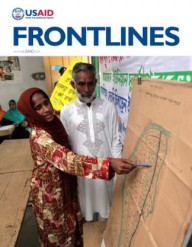

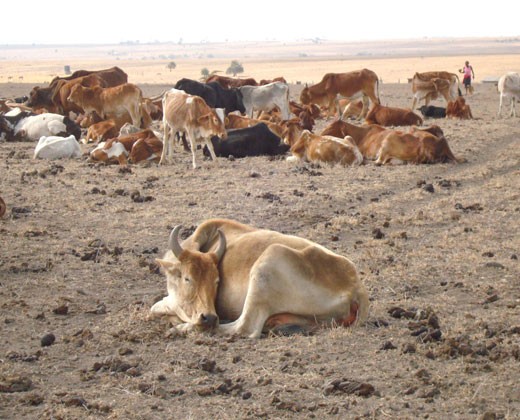

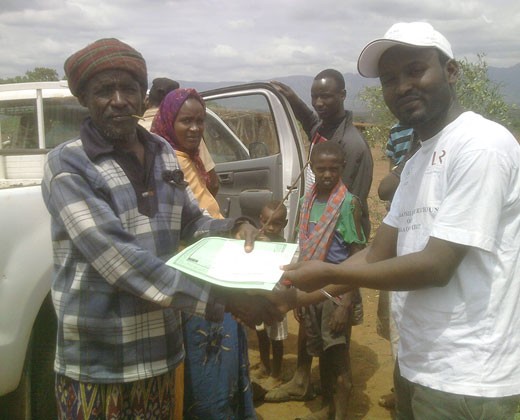
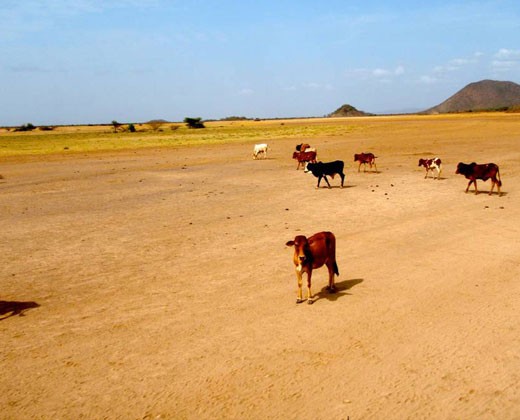
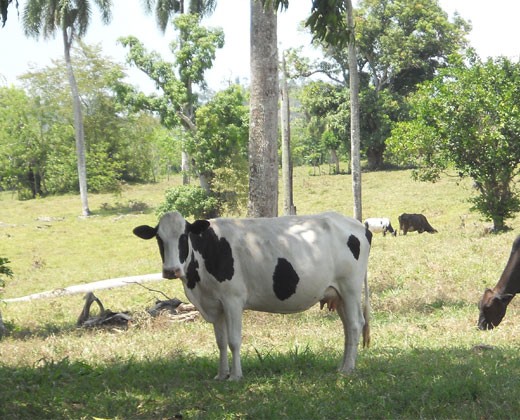
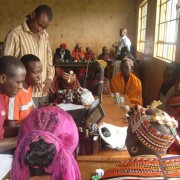
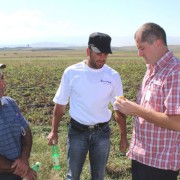
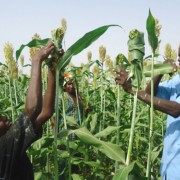
Comment
Make a general inquiry or suggest an improvement.